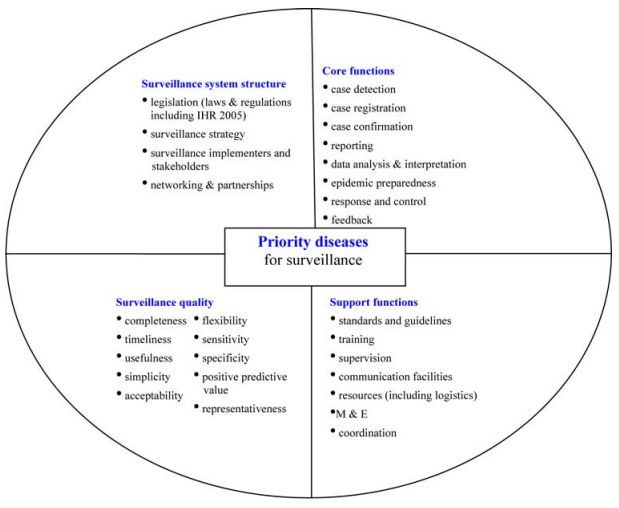Disease Surveillance System
This article is based on A disease surveillance system, for the future which was published in The Hindu on 24/09/2021. It talks about the significance of disease surveillance programmes and suggests a way forward to strengthen the system.
Surveillance is the systematic collection, analysis, and interpretation of outcome specific data for use in planning, implementing and evaluating public health policies and practices.
A disease surveillance system serves two key functions; early warning of potential threats to public health and programme monitoring functions which may be disease specific or multi-disease in nature.
In the second half of Twentieth century, as part of the global efforts for smallpox eradication and then to tackle many emerging and re-emerging diseases, many countries recognised the importance and started to invest in and strengthen the disease surveillance system. These efforts received further boost with the emergence of Avian flu in 1997 and the Severe Acute Respiratory Syndrome (SARS) outbreak in 2002-04.
Disease Surveillance System in India
- A major cholera outbreak in Delhi in 1988 and the Surat plague outbreak of 1994, nudged the Government of India to launch the National Surveillance Programme for Communicable Diseases in 1997.
- However, this initiative remained rudimentary till, in wake of the SARS outbreak, in 2004, India launched the Integrated Disease Surveillance Project (IDSP).
- The focus under the IDSP was to increase government funding for disease surveillance, strengthen laboratory capacity, train the health workforce and have at least one trained epidemiologist in every district of India.
- With that, between 2004 and 2019, nearly every passing year, more outbreaks were detected and investigated than the previous year.
Epidemiology
- Epidemiology is the study and analysis of the distribution, patterns and determinants of health and disease conditions in defined populations.
- It is a cornerstone of public health, and shapes policy decisions and evidence-based practice by identifying risk factors for disease and targets for pre
- It is to initiate action to either prevent or stop further spread, a process termed as disease surveillance.
Need For Surveillance System
- Better Management of Health Care System: When diseases are predictable, theoretically, health systems can be designed to manage them.
- For example, if hospitals know the seasonality of influenza, pneumonia or diarrhoea, they can plan for the surge in admissions, ensuring that beds and staff are available when needed.
- Increased Threats From India’s Diverse Nature: In a country with 1.3 billion people, with a marked inequity in health care, dense urban populations, multiple contact with domestic and wild animals, frequent internal migration, a large diaspora, international air links and a warm climate, we are uniquely positioned to be most at threat from indigenous and imported infectious diseases.
- Illness Identified at the Earliest: In a well-functioning disease surveillance system, an increase in cases of any illness would be identified very quickly.
- An example is Kerala, one of the best performing disease surveillance states in India, as it is picking the maximum Covid-19 cases; it could pick the first case of the Nipah virus in early September 2021.
- On the contrary, cases of dengue, malaria, leptospirosis and scrub typhus received attention only when more than three dozen deaths were reported in multiple districts of Uttar Pradesh.
Way Forward
- Increase the Funding: The government resources allocated to preventive and promotive health services and disease surveillance need to be increased by the Union and State governments.
- Train the Workforce: The workforce in the primary health-care system in both rural and urban areas needs to be retrained in disease surveillance and public health actions.
- The vacancies of surveillance staff at all levels need to be urgently filled in.
- Capacity Building: The laboratory capacity for Covid-19, developed in the last 18 months, needs to be planned and repurposed to increase the ability to conduct testing for other public health challenges and infections.
- This should be linked to create a system in which samples collected are quickly transported and tested and the reports are available in real time.
- Adopting ‘One Health’ Approach: The emerging outbreaks of zoonotic diseases, be it the Nipah virus in Kerala or avian flu in other States as well as scrub typhus in Uttar Pradesh, are a reminder of the interconnectedness of human and animal health.
- Thus, the ‘One Health’ approach has to be promoted beyond policy discourses and made functional on the ground.
- Strengthening the Registration System: There has to be a dedicated focus on strengthening the civil registration and vital statistics (CRVS) systems and medical certification of cause of deaths (MCCD).
- These are complementary to disease surveillance systems and often where one is weak, the other is also functioning sub-optimally.
- Need For Coordinated Action: It is also time to ensure coordinated actions between the State government and municipal corporation to develop joint action plans and assume responsibility for public health and disease surveillance.
- The allocation made by the 15th Finance Commission to corporations for health should be used to activate this process.
Conclusion
The emergence and re-emergence of new and old diseases and an increase in cases of endemic diseases are partly unavoidable. We cannot prevent every single outbreak but with a well-functioning disease surveillance system and with application of principles of epidemiology, we can reduce their impact.
Indian States urgently need to do everything to start detecting diseases, which will prepare the country for all future outbreaks, epidemics and pandemics. This is amongst the first things, which Indian health policy makers should pay attention to.
|
Drishti Mains Question ‘We cannot prevent every single outbreak but with a well-functioning disease surveillance system, we can reduce their impact.’ Discuss. |

